
In Phoenix, Arizona there is a man at a workbench stuffing a small guitar amplifier chassis full of electronic components to its limits. Why is he doing this you may ask? Because he can! Henry Heistand is the owner and builder of RedPlate amps; the small, compact amps that sing… and sing they do. Just listen to Elvin Bishop, Tommy Castro or Ronnie Baker Brooks and the many video/soundclips on his website and you will hear how these little amps sing. Henry has figured a way to produce a very compact, hand-wired amp with big sound and no oscillation issues. In this interview you will find out how Henry got started, the principles he uses to build a great amp and some detailed info about these little giants. Oh, and they are Red too!
300guitars: Hi there Henry. Please tell us a little about yourself and when you got into building guitar amplifiers.
Henry Heistand: I’m 53 and my first build in 1969 was a speaker cabinet made out of 1/2″ plywood and covered with yellow carpeting. It had a leopard (spotted) grill cloth and contained 6 speakers recycled from various old TV’s and Stereo’s. My first real amp repair was replacing a screen resistor in a Fender Bassman in 1970. I went to college for a year and then played guitar full time until 1979 when I attended electronics school (they still taught tubes). To pay for school I got a part time job at a church organ repair shop and still played on weekends. In late ’82 I got a “career” job in the computer field. In 1988 my old employer at the church organ repair shop called me out of the blue and sold me the portion of his business that repaired “combo” gear. I rented some retail space, hired an employee and started a company named Music Mechanix doing warranty work for all the majors. In addition to repairs I did all the popular mods of the day, many times redoing everything inside but keeping the exterior unchanged. I became so busy I forgot how to sleep so after about 5 years I sold the business and let my day job move me to Arizona. I had always been fascinated with “sleeper” amps that looked small but sounded big. I did a lot of experimentation on point to point builds in a Fender Champ sized chassis, eventually working out how to do a 7 tube, large transformer build in a Champ chassis without noise or oscillation.
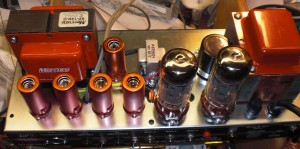
300guitars: How did the Red Plate amp company come about?
Henry Heistand: I mostly started the company so I could get distributor pricing on parts. (lol), it officially started in the spring of 2006. The name “RedPlate” is a common tube term that the old timers used to describe tube plates glowing red. I thought it was appropriate because I had heard several musicians over the years say the best sound an amplifier could produce involved output tubes running at the edge of thermal meltdown. I actually bias my production amps fairly cold, they just sound like they’re biased hot.
300guitars: The concept of a small amp with big sound is not a new one. What was your inspiration to go this route?
Henry Heistand: Well it turns out size does matter, at first it was all about convenience; guitar in one hand, amp in the other and off to the jam you go and hey, the amp fits behind the front seat! Later it became about old dudes and their weak backs or current airplane baggage weight restrictions. One of my first pro builds was for Mighty Mike Schermer who said that doing a gig in San Francisco can mean parking 17 blocks away and it’s highly desirable to do the load in with one trip. This means the amp must be small. Another S.F. area resident, Kid Andersen, sometimes carries his amp and guitar to gigs on a city bus. The 50 pound per bag airplane restriction is another challenge because you have to factor in the weight of a good roadcase. The internals of keeping the noise down and uncomplimentary signal paths apart without treble squealing are much trickier in a small point to point build especially since I use eyelet boards and oversized components (like all good non PCB boutique builders). A lot of trial and error went into the process, I actually think the limited space can be an asset and can contribute to the harmonics and sustain from allowing a slight amount of PPPF (placement passive positive feedback).
300guitars: What are your Red Plate amps based on?
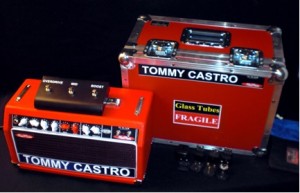
Henry Heistand: I base my amps on the Western Electric designs or RCA tube manual like everyone else – (insert tongue in cheek). Amp builders are like comedians, there is no shame in stealing good material. When I had the repair business I did a lot of Frankenstein amps that were Fender this, Marshall that with a sprinkling of Vox and Ampeg thrown in for good measure. I was continuing the warranty station status the original owner had established so I had every original manufacturer’s amplifier schematic from about 1952 on as a reference source, residing in 16 large file cabinets. At the time I was still doing weekend warrior gigs using a pair of modified Ampeg VT-40’s in stereo until somehow I ended up with a Mesa Boogie S.O.B. that had a really innovative phase inverter section controlled by a “LIMIT” knob. That circuit was not in the RCA manual or on any other schematic. It sparked something in me and from then on I started doing creative amp mods that were not copies of things I had seen on schematics. Fast forward to today where I’ve been heavily influenced by the Dumble ODS clone craze and the generous sharing of ideas between folks in that internet community. The recorded sound of Dumble and early Mesa Boogie amps have always been my favorite and I try to get some of that singing tonal character in every model I make – even the little Harmonicamp.
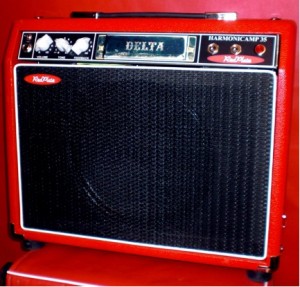
300guitars: What are the differences between your “Improved Blackface” amps and the TweedyVerb?
Henry Heistand: As the names might imply, one has the traditional treble, middle, bass tonestack (with a slope resistor) and the other has a single tone knob (no slope). Most players can identify with the ‘60’s or ‘70’s Blackface Fender amp tone so I tried for a preamp that reproduced their romanticized memory of that tone. The TweedyVerb is a much hotter preamp so it has less clean headroom but it is unclean in a very musical way so you can still do rhythms at loud volumes. I call it “Clean with Character”.
300guitars: What are the standard features of a Red Plate TweedyVerb?
Henry Heistand: The base TweedyVerb model has evolved from a Volume, Tone, Reverb 3 knob amp to a 4 knob amp. I had to include a preamp/master volume pair so it could be used at small clubs. There really is no standard build because every amp is customized to the individuals wants. A Clean-Funky-Dirty switch or pull pot for clean are examples of features considered as part of the standard base model if a customer wants them. I don’t do the metal chassis, wood, grill cloth or tolex work. The steel chassis is fabricated at a local metal shop, LopoLine in California does the really small combo cabinets and I have a local cabinet maker that does the heads and larger cabinets. He is especially good at custom work. Dovetail joints pine sides and void free plywood baffles are his usual standard. Speakers in the smaller single speaker combo amps are either Eminence TonkerLite or lil’ Texas Neo’s for light weight or WGS Britsh lead 12’s or Eminence Red White and Blues. My favorite 10″ in a single speaker configuration is the Eminence Ramrod.
On all the builds I always use PS series Orange Drops and carbon comp resistors in the signal path and metal films for Plate/Cathodes. I also use the JJ 40-20-20-20 can cap for preamp filtering. Bypass caps and main B+ caps are generally Sprague, Illinois or Nichicon, depending on what’s readily available.
I also always use the EH 12AX7 preamp tubes as well as the JJ 12AT7 or Sovtek 12AX7LP for the PI (depending on amp model). The 6L6 output tubes are ordered in batches and in the past have been Sovtek, Ruby, TAD, TungSol or EH. The current run of amps are using the “domestic only” version of the Svetlana “Winged C”.
300guitars: Does the TweedyVerb model have a negative feedback loop?
Henry Heistand: Yes, it does have a hardwired presence circuit which usually is set like you had a presence knob on 8. This is another one of those features that I consider part of a standard build if the customer wants the control on the front panel. If the build does get a control on the panel I usually use a potentiometer with an off position to remove the negative feedback completely when rotated to 0.
300guitars: What are the weights and measurements of your amps?
Henry Heistand: RedPlate Heads are 17 x 9 x 8 and around 28 Pounds. The 10″ combo is 17 x 14 x 7 and 35 pounds. The 12″ Combo is either 17 x 16 x 7 and 35 pounds or 17 x 17 x 10 and 40 pounds. I will be introducing a new model next month to accommodate 4 output tubes (100 watt) that will be 2 inches wider.
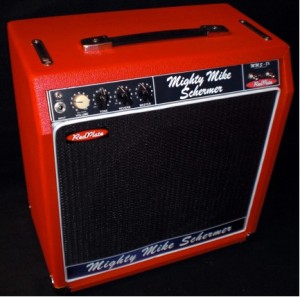
300guitars: What custom options do you offer for the TweedyVerb?
Henry Heistand: I do my own fascia so all RedPlate amps can have anything you can dream up on the control panels as part of a standard build. The tolex can be any color as long as it’s red, and I also offer overdrive, Mercury Magnetics output transformer and world power options. The combo cab options can be custom sized for bass response and can be open or oval ported back. Any speaker brand, size or configuration can be accommodated. Most of my TweedyVerb customers contact me right after seeing Ronnie Baker Brooks and want a clone of his amp.
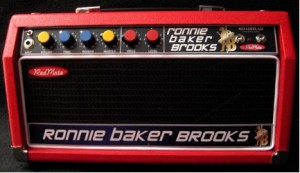
300guitars: Do you build custom amp models as well?
Henry Heistand: They are really all custom amps but to specifically answer your question – Yes and no, RedPlate amps use either a 15″ or 17″ chassis width and too many add on options can make a build run out of real estate pretty quickly. All chassis’s can be configured for two output tubes (50 watt) with the largest chassis also able to handle 4 (100 watt). The big problem with options is number of preamp tubes required and panel room for all those extra controls. I try to accommodate what a customer wants when it is physically possible. To tell you the truth, most guys who contact me that want every option under the sun scare me. They are usually looking for “talent in a box” and no amp will satisfy them. My amps are not bedroom amps, they are made for the stage with the performance in mind and designed to sound good at the back of the room all night with minimal knob twiddling. Most of the pro customers do everything from the guitar.
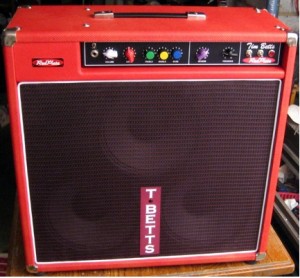
300guitars: You have a large blues player clientele. Are your Red Plate amps able to cover many different players’ styles besides the blues?
Henry Heistand: You mean Tommy Castro is not a country artist? Most “blues” amps seem to be all about overdriven character and although that is important, I concentrate more on clean singing harmonics, get that right and everything else falls into place. So the short answer is yes these are much more than just blues amps. If a player specifically wants an amp to shine at one style I can make design changes accordingly.
300guitars: A cathode biased 40 watt amp can be loud and will cut a lot of gigs. Can it also be used in smaller situations and lower volume recording without losing its tone and dynamics?
Henry Heistand: The TweedyVerbs are cathode biased, the “Improved Blackface” models are standard fixed bias but the issue of keeping the tone at low volumes is the same for both. Hopefully the studio has a room where you can play at gig volumes and capture the sound that way. The clean sounds are no problem, the harmonics will sing at pretty much any volume but the big overdriven tube amp sound suffers at low volumes. Volume girth is volume girth and not even the separate amp method attenuators can quite simulate it. Good bedroom amps have what I call “music store syndrome” – what sounds great in the store or living room won’t project past the edge of the stage in a live situation. I don’t discourage the use of attenuators; I’m just not building for that market.
300guitars: Shifting gears a bit here, what type of music do you like and who are some of your favorite artists?
Henry Heistand: Blues, Fusion, Modern Jazz, non-commercial funk, instrumentals, anything with good vocals or interesting lyrics, not necessarily in that order. A great guitar part with great tone is always a plus. Larry Carlton, Robben Ford, Wes Montgomery, Kenny Burrell, Frank Gambale,etc. etc. This list would take all day. I haven’t covered the blues guys yet.
300guitars: What kind of guitars do you play?
Henry Heistand: Mostly a Nashville Custom shop 335 (1980), and a stock rosewood board Tele (1988), occasionally a Martin Taylor Yamaha. I have other good guitars in dusty cases I haven’t opened in 10 years
300guitars: Do you still play live gigs and use the gigs as a sort of proving ground for designs?
Henry Heistand: No I don’t have the time or inclination to keep my chops up. Amp building satisfies me in ways that playing never did and my wife doesn’t have to worry about groupies. I do have a couple of local guys that will guinea pig my new designs on gigs for projection. When I first started production I wouldn’t ship an amp until it did a 4 hour gig. Now I rely on bench burn in and vibration testing.
300guitars: What are your future plans for Red Plate amps?
Henry Heistand: The current models have evolved to a point that the overall design is not going to change much going forward. Recently I’ve been working in a new 17″chassis where I can have more options but it’s really just a combination of things that have already been done in the smaller chassis. I take my customer’s first tonal impressions to heart and keep them in mind when I think about incorporating design or model changes but I haven’t identified a niche that current models can’t satisfy. On the manufacturing side I want to eventually expand to a larger facility and have a few employee/partners without compromising the tone or reliability. I still want to do the design phase, install the critical signal path components and personally tweak every amp but I would be ok with someone else drilling the eyelet board and mounting the hardware. It would be nice to have a shipping/receiving department and a full time cabinet person, and it would be really nice to have an accountant. Maybe I could build 2 amps a week instead of just one.
300guitars: Thanks alot Henry for taking the time for this interview. I wish you much success with your amps in the future!
Henry Heistand: I appreciate the chance to be introduced to your readers, it’s websites like this one that make the internet such a valuable resource for today’s musicians. In the future, I’ll try and keep you guys honest when you recommend amp modifications in your articles ;lol).
Visit Henry’s RedPlate website here for more detailed information about these great amps.